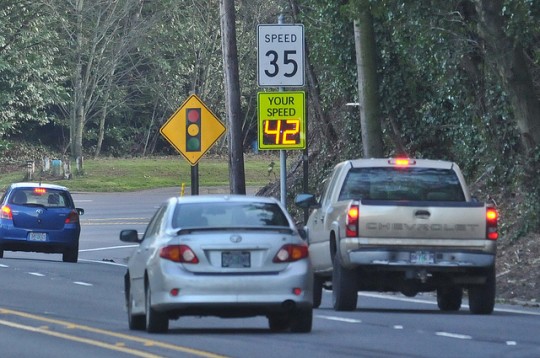
(Photos: J.Maus/BikePortland)
When it comes to the rules of the road, there are a few facts of life — or, as sociologists might call them, social norms.
When people are in cars, they tend to drive over the speed limit if they feel it’s safe to do so and they can get away with it.
When people are on bikes, they tend to roll through stop signs if they feel it’s safe to do so and they can get away with it.
When people are on foot, they tend to cross the street whenever they feel it’s safe to do so and they can get away with it.
The key difference between those scenarios is that one of them is far more likely to result in injuring or killing someone other than the person doing it. It’s also, of the three, possibly the most commonly broken law in the history of the world — and of the three, the least likely to provoke outrage by an average American.
The city says that according to law enforcement records, at least 46 percent of metro-area traffic fatalities are speed-related. That doesn’t include fatalities that may have been coded with different factors — drunken driving, for example — but were also speed-related.
In 2013, the last year with full statistics available, traffic killed 109 people in the four-county metro area.
Speeding may be against the law, but in the United States it’s as powerful a social norm as stopping for a red light even if nobody else is coming.
This wasn’t always the case. In 1923, the U.S. auto industry successfully killed a campaign to install a device in every car that would force it to drive at a mostly nonlethal 25 mph.
Now the City of Portland is essentially proposing something similar, except only for its 10 most dangerous streets: to install automatic cameras that would send tickets to people who break the law by exceeding speed limits by more than several miles per hour.
Here’s why that matters: it has the potential to change social norms just as surely as the 25-mph devices might have if they’d ever been installed, back in 1923.
There’s no question that the perception of “bicyclists” as “scofflaws” is one of the single biggest political problems of bicycling advocacy. When one human sees another violating a social norm — especially someone who looks different or unfamiliar in some way — we feel a powerful urge to put them into the drawer in our brain labeled Others.
Six years ago, Oregon’s bicycling advocacy community more or less fell on its own sword in a failed attempt to get around this problem by legalizing something that most people do anyway — treat stop signs as yield signs.
Advertisement
Today, there’s a bill in Salem that turns things on its head. Instead of trying to legalize an illegal social norm (rolling through stop signs on a bike) it tries to enforce penalties of a social norm that’s already illegal (speeding on dangerous streets in a car).
And here’s the interesting thing: because speeding is already both illegal and obviously dangerous, some people are willing to turn against it. The Oregonian comment section, rarely more than a torrent of hatred toward various Others, is surprisingly divided about the merits of this bill.
To be clear, maybe three-quarters of the comments about this bill on the Oregonian’s website seem to oppose it, or at least to argue that it’s more about revenue than safety. (An opinion that, to be honest, isn’t ridiculous.)
But for city lovers and safety advocates, the real promise of speed-detection cameras isn’t that they’d bring in money, or even that they’d impose legal penalties on some drivers.
The promise of speed-detection cameras is that because they’re self-financing, it’s possible to install enough of them to change the social norm. The promise of speed cameras is that they might once again turn people who drive at illegally lethal speeds into the Other.



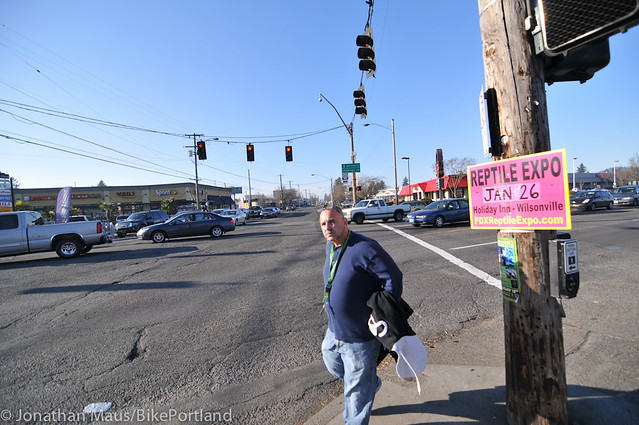
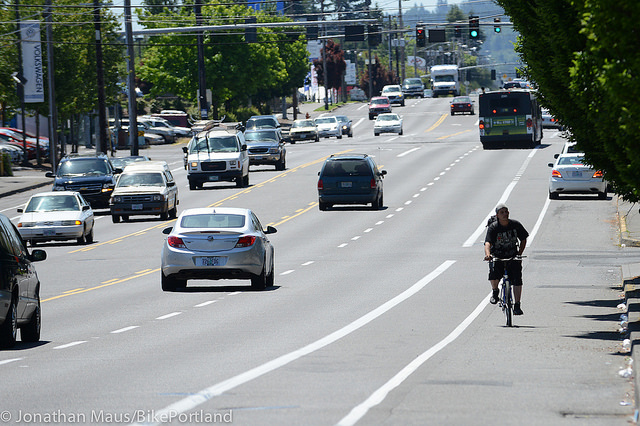

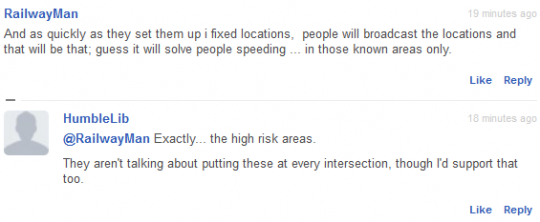

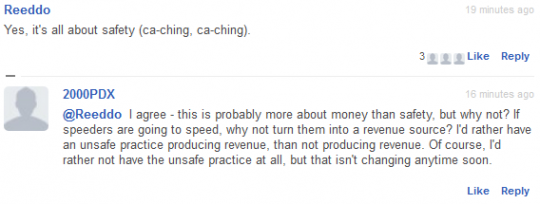
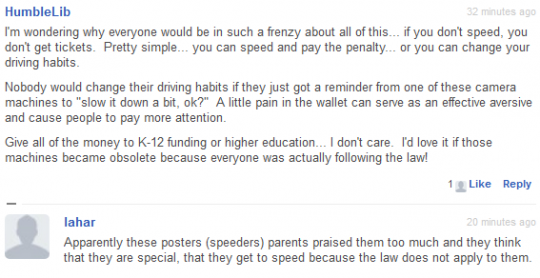
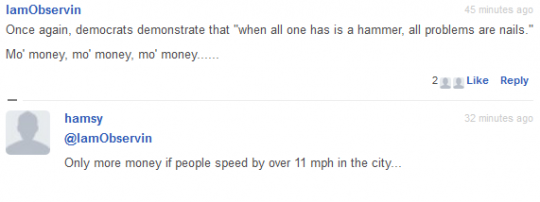


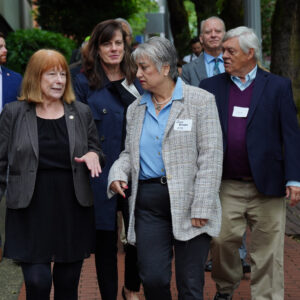
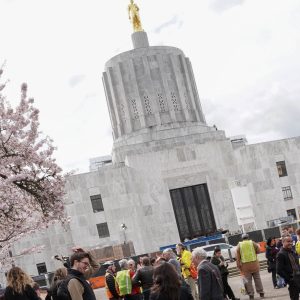
Thanks for reading.
BikePortland has served this community with independent community journalism since 2005. We rely on subscriptions from readers like you to survive. Your financial support is vital in keeping this valuable resource alive and well.
Please subscribe today to strengthen and expand our work.
Love this, spot on. I’ve been bouncing around many of the same ideas since spending 5′ this weekend observing the “Your Speed” sign at the end of my block, at 35th and Holgate. Law abiders were definitely in the minority, if they existed at all!
I need to go back out there with a pen and paper and record the results one day.
that sign is working again? I was sad when it went dark… haven’t seen it on in a while…
btw, I think the “your speed” signs are great because they let everybody around you know that you’re speeding and it puts a little peer pressure on the driver… I wish they had these all over the place…
You forget that there are human beings driving those cars. And the natural human tendency will be to rationalize, deny and deflect. “Huh? My speed is 49 mph in this 40 mph zone? No way. Must be the guy in the red Range Rover that I just passed. I’m a good driver. I don’t break the law..”
“I’m a good driver. I don’t break the law..”
First we have to re-establish in people’s minds the notion that going 49 in a 40 is actually “breaking the law”. I think many drivers don’t believe this; they interpret the “basic rule” as allowing them to go as fast as they want (even over the speed limit), as long as they do it “safely”. Besides, nobody gets a ticket until they go 15 over anyway, so it must be OK.
I liked the one on N Willamette where it turns into Rosa Parks. Always fun when your noodly legs can whip up enough speed to make it flash after a few thousand feet of climbing in the West Hills.
Michael I’m for this bill, but I don’t understand why you need to open the article the way you did? Just saying speeding is bad is sufficient (and I really don’t think anyone on this site would argue with you about that). Just too red meat-ish for this site.
I disagree, davemess. I took Michael’s points to be that (a) violations of laws by people using different modes are not equivalent, and (b) that thanks to Car-head we have normalized the one kind of infraction that actually matters.
I agree with 9watts. I’ve been a passenger in a car where the driver was complaining about cyclists breaking the law–while she was speeding! I thought the article’s opening did a good job setting up the main thrust of the article, which is that norms are at least as important as law, and that norms are usually adopted unconsciously and irrationally.
I concur with both of you. Beautifully put in the opening, Michael.
I’ve actually got to credit my friend Lenny Anderson (formerly of Swan Island TMA) for the triadic structure of the opening; he’s the one I first heard that list from.
“Michael I’m for this bill, but I don’t understand why you need to open the article the way you did? …” davemess
It sounds like people attempting to seek revenge and get their licks in, rather than prioritizing the development of a balanced view that could accomplish something worthy.
Elsewhere in the comments, too much raw, compulsive animosity expressed through the use of words such as ‘car head’. Are advocates of biking that use this word, seeking to be responded to with a similiar animosity driven word such as ‘bike head’, from people that drive? You call them your word, they call you their word for them, or worse. Not really constructive progress in road user relations.
The red light camera, speed light camera idea is a good one though, that I think plenty of people as road users with bikes and cars both, are ready to support. Often, road traffic becomes madness because of a minority of people speeding excessively, that virtually run roughshod over all other road users. Their abuse of the road and the people trying to use it responsibly, raises tension amongst many road users, as well as danger that most road users have some sense of. It makes dysfunctional, well engineered, safe roads.
I don’t buy the suggestion that speeding on the part of people driving, has been “…normalized…”, as watts chose to put it. Speeding on some roads is out of control, but it’s not normal; it’s abnormal. People that excessively speed, don’t get cut slack in any official or social form of acceptance. They exist only because practical, cost effective means of effectively curtailing their abuse of other road users, has not been available, until now. Cameras to the rescue.
Scofflaw cyclists deserve no slack. They’re a real problem too, and no less deserving of social and enforcement pressure to stop it. It’s a matter of how to get that done.
Scofflaw cyclists deserve no slack. They’re a real problem too, and no less deserving of social and enforcement pressure to stop it.
A real problem with little to no negative impact on others or society.
“It sounds like people attempting to seek revenge and get their licks in, rather than prioritizing the development of a balanced view that could accomplish something worthy.”
You are overlooking the very real, material differences between the law breaking by people in cars and the law breaking by just about everyone else on the road. It is kind of hard to ‘balance’ the view when the situation we’re looking at is so lopsided.
Elsewhere in the comments, too much raw, compulsive animosity expressed through the use of words such as ‘car head’.
If you had met Alan Durning you would I think agree that he is the least raw, compulsive, animose person I think I’ve ever met. His coining of that term couldn’t have been further from what you are inferring.
“Are advocates of biking that use this word, seeking to be responded to with a similiar animosity driven word such as ‘bike head’, from people that drive? You call them your word, they call you their word for them, or worse. Not really constructive progress in road user relations.”
Again you are seeking to superimpose some equivalence here that is not present. If you would trouble yourself to familiarize yourself with what the term Car-head refers to you would understand that there is no such thing as bike-head in this country. That was the point in coining the term in the first place: it points to an asymmetry in how we think about these things in this country. You may not like someone pointing this out, but that doesn’t change the underlying realities Durning was focusing on.
“I don’t buy the suggestion that speeding on the part of people driving, has been “…normalized…”, as watts chose to put it.”
Actually when you and I have discussed this in the past you refused to acknowledge that this was even common. Your response at the time: “Everyone does not regard the speed limit as the minimum. […] Vehicles on streets and thoroughfares out here seem to generally travel either at or within 5mph of the speed limit, some under than the speed limit, some over the speed limit. […] Some people do travel more than 5 mph over the speed limit, but they seem to be the minority by far.”
“Speeding on some roads is out of control, but it’s not normal; it’s abnormal. People that excessively speed, don’t get cut slack in any official or social form of acceptance.”
You are creating a new category: excessive speeding, but what we are talking about, what these cameras are designed to punish, and what they find is going on in other jurisdictions where they’ve been installed is that speeding is very much everyday; it is so common we don’t even notice it. In fact, as several people here have pointed out, if you refuse to speed you can expect to be harassed by people behind you who are prevented from speeding by your behavior.
“Scofflaw cyclists deserve no slack. They’re a real problem too, and no less deserving of social and enforcement pressure to stop it. It’s a matter of how to get that done.”
How did this sneak in here? Were we talking about people on bikes speeding? Is that even a problem? There’s your need for equivalence sneaking in again. Time to give that one up, wsbob.
“I don’t buy the suggestion that speeding on the part of people driving, has been “…normalized…”, as watts chose to put it.”
You’re being willfully obtuse if you think that most drivers operate their vehicles at or below posted speed limits. Casual observation of virtually any traffic anywhere dispels your assertion. If you don’t “buy” what most people consider common knowledge, then at least have the decency to come at us with some data.
This is what keeps me believing that drivers are a separate, subhuman species–I have been able to comprehend 2 digit numbers since I was about six years old. What is motoring primates’ problem with comprehending a 2 digit number on a roadside sign and keeping the gauge in their car matched to it? This is, as they say, far from brain surgery.
Selfishness?
Inattentiveness, distractedness, complacency….
“Selfishness?”
exactly…
And can the same be said of anyone who breaks the law??
Are the salmon shown in the photo of 122nd being selfish? The don’t seem to care about anyone but themselves?
In that instance, it’s more likely the problem is ignorance.
“And can the same be said of anyone who breaks the law??”
no…
“Are the salmon shown in the photo of 122nd being selfish?”
yes…
I try to be very aware of my speed while in a car and keep it at or below the limit, unless there’s heavy traffic and then I go as slow as I feel comfortable with. On a frequent basis I am harassed by drivers behind me. I used to live off Willamette Blvd. At least once a week someone would honk, tailgate, and eventually illegally pass me so they could go 50 instead of the posted 35. When I drive to work, part of my commute takes me on SE 21st between Powell and Division. This street during morning rush hour is full of bikes in both directions, kids crossing the street, car traffic, delivery trucks…pretty much chock full of traffic. Often there is no way to safely pass the bikes in front of me because of opposite direction traffic, and me going the 12-15 mph speed of the bikes ROYALLY pisses off some drivers. One morning a very lovely woman in a Mercedes intentionally bumped me to let me know how terrible I was.
Long story short, the social pressure to speed is strong, and the behavior of many can actually make not speeding dangerous. Not that I intend to speed for the convenience of others, but I can see how people would bow to the pressure.
I make a point of driving a bit under the speed limit and experience road rage far more than when I bike. There is something about being “safely” encased in a metal box that provokes an angry and territorial response from seemingly normal people. It reminds me of my cat companion: if he is below me he is very affectionate but the minute he is on a perch above me he is a ferocious beast who desires my blood. Cars do for people what height does for cats.
The two-digit thing reminds me I had a 1990 car capable of going three digits, but the speedometer only went up to 80 or 85. Unless it’s a race car, there’s no need to have speedometers go even higher.
Speeding cameras sound great. I would also love to see some cameras for cars that roll through the bike boxes, block the crosswalk then turn against an obvious “NO TURN ON RED” sign. Just about any traffic/law enforcement that can easily be automated probably should be. Cops have enough work as it is, without worrying about your average traffic violation.
The city also should ban all right turns on red.
I’m curious about this view that I’ve seen espoused a few times here lately. Rights on red have never struck me as a particular hazard. Yes, I recognize some people are negligent in looking for peds, but that is equally the case at green light turns, in my observation. Are you worried about right hooks to bikes, because there the bike should be stopped, too, so that doesn’t strike me as a special concern.
I think rights (and lefts) on red are a very efficient tool, and I’ve personally never had any issue executing one safely. Is it an issue of enforcement against those who do it unsafely, or do we really need to ban them outright?
Right on red is a known pedestrian-killer and also a cyclist killer when there is a bike lane as drivers assume that since there isn’t a car or truck to their left it’s clear to go and run right over the cyclist ir pedestrian in front of them.
Thanks for the feedback. I guess I do observe a lot of right-on-reds focused solely on traffic coming from the left, good point. But again I feel that at least car operators making a right on red are conscious (of something), versus a right on green they feel they have no obligation to look for anyone anywhere. But that’s pure anecdote, anyone have data?
There should be bus/train-mounted cameras that capture drivers who drive in/make illegal right turns on the transit mall.
The photo at top is one I go by every day on Barbur. Even when the entire section was set to 35 mph during construction last fall, and signs said that fines were double because of the construction zone, people still blasted past that sign.
I feel that, much like celestial bodies, cars tend to whip around bikes for whatever reason… like they speed up 5mph when they see you, and arc around while accelerating…
This makes sense if there isn’t an extra lane or dedicated bike path. If I have to pass someone by moving to the center or other side of the road, I want to expose myself to oncoming traffic for as short of a window as possible. This is true as a rider and a driver.
I’m not sure if statistics bear this out, but I suspect this behavior is also safer for the cyclist, because if there is an oncoming car, there may be a strong instinctive reaction to swerve back into the lane, hitting the cyclist.
If there is an oncoming car, it’s not safe for you to pass.
Completely agree. I’m not saying you should aggressively exploit small gaps in traffic. But it’s not always clear that there will be oncoming cars. Say you’re on Skyline. The curves keep you from seeing too far ahead. You’re following a cyclist. You see an opening, but you can’t dawdle. If you do, a car could come around the curve, endangering both of you. So you step on it.
As a cyclist who rides Skyline, this is the behavior I would want out of a driver. Too many drivers just pass on a blind curve, which terrifies me, or take their time, which is better but still scary. I want them to slow down, follow me, and wait until they know that they can pass me even if a car comes round the next bend. But if they wait for a straight long enough so that they won’t have to step on it in order to pass me, they’ll be trailing me for a really long time, which also makes me nervous and irritated.
i am referring to the photo of Barbur above… i bet you a million dollars that cars go faster there in the presence of a bike in the bike lane.
I believe that the certainty of a ticket for speeding is more of a deterrent than a high fine (which proportionally affects the poor far more than the rich). How about a $20 fine for 0-5 mph over, with the added nuisance of requiring each ticket to be paid for individually — 5 tickets makes five trips to the payment window or 5 checks in five envelopes with five stamps.
poor people drive better because they can’t afford a ticket…
Well said, Michael. Thanks.
I’m a “motoring primate” and I support House Bill 2621.
I love the opening to this article. It’s important to put things in perspective. Everybody violates the letter of the law at times, but when driving motorized appliances, the consequences can be huge; a level so far and above biking or walking that there is no comparison.
Great article, thanks. I sincerely hope the cameras get voted in.
The solution to people broadcasting the locations is simple: Move the cameras around, and replace them with dummy-cameras so that no-one knows where the real ones are. This is tried and tested in other countries
Have a bunch of people report cameras on Waze around the entire city. People will think there are cameras everywhere and won’t drive fast anywhere!
In order to change any behavior, the most effective stimulus is one that is intermittent. If we had ubiquitous cheap boxes over every traffic intersection, with a small minority of ones that take pictures indistinguishable from ones that do not, and a system of alternating them at random, speeding would disappear. It is really that simple. Panopticon.
Please just don’t save the data in some mega storing facility in Utah.
This is exactly what they do in europe. Lots of camera boxes with a smaller number of cameras. It’s incredibly effective.
I would go a step further. Even more effective than punishment for unwanted behaviors is intermittent reinforcement for wanted ones. If I had expendable income, I’d start a non-profit with the sole purpose of rewarding road users for safe behavior. People report in with specific license plates and details and one safe person per month gets some sort of free restaurant card or whatever.
Imagine thinking about a reward for being safe (and not just a punishment) when you are driving. It makes the choice abundantly clear, but it also causes reflection on why these expectations exist, and how that is different from the norm (say for speeding).
I’ve known of small-town police forces doing this, but not recently…
The city would also broadcast the locations.
What will be the threshold speed that will trigger the camera? I read the actual bill summary (see link below) and it does not specify. I truly hope that there isn’t a 10 mph cushion (i.e., no ticket issued unless the driver was exceeding the posted speed limit by at least 10 mph). That will essentially encourage speeding. And, IMHO as a recent arrival to these fair shores, posted speed limits around here are way too high anyway. 45 mph on windy narrow two-lane NW Cornell Rd below Skyline / Miller? Really? Most people drive at least 50 on that stretch, if not more.
https://olis.leg.state.or.us/liz/2015R1/Downloads/MeasureDocument/HB2621/Introduced
Do it like the Aussies do in Sydney (where I lived for several years): red light cameras and speed cameras (with minimal to no speed cushion) and install the cameras on the “motorways” too (the OR bill seems to exclude the freeways).
http://roadsafety.transport.nsw.gov.au/speeding/speedcameras/index.html
“45 mph on windy narrow two-lane NW Cornell Rd below Skyline / Miller?”
people hate me when I drive that stretch because I’m usually going 35 mph because it’s very obviously posted too fast since you can’t see far enough around the corners to go faster than 35 mph and avoid a stopped vehicle safely… there’s a ton of driveways on blind corners and I’m not going to risk everybody’s life just so I can catch up to the stopped traffic at NW 23rd a little faster…
According to city specialist Gabe Graff, the buffer between speed limit and citation trigger will be wide enough to remove the probability of error by the device. He wasn’t willing to say publicly how wide that would be, since of course the goal is to get people to drive the actual limit.
The fact that the manned devices have a 10mph buffer strongly suggests to me that these would, too.
This is great news, and a good step toward Vision Zero. There is no rational reason to be against these cameras. The only arguments I hear are “I want to drive fast” and “it’s all about money”. The first is ridiculous – if you don’t want a ticket, then don’t drive past the posted speed limit. Regarding the second – we’re we not just talking all last year about how the city has no money?
To be clear, I’m very much a supporter of this bill. On the other hand, to play the other side for the sake of discussion, I do think there are rational reasons to be concerned other than “wanting to speed.” For one, I believe avoiding a police state mentality is a valid concern. This bill is narrowly constructed as a viable tool against a specific, real safety problem. But what if the bill was to issue photo citations to those crossing a crosswalk against the signal, even where there was no hazard to anyone? “Slippery slope” arguments are often irrational, so maybe this doesn’t fully meet your test, but I do think the underlying concern (the police state) is a legitimate one.
When I was a kid there was a “seatbelt law” enacted in my home state and it created a huge public outrage. My Mom and Dad screamed that it was their choice whether to wear one or not, and then it was repealed by voters and everyone was happy again. It was enacted again not long after, repealed by voters again, and then permanently enacted – the federal government threatened to withhold large chunks of funding for the ‘dangerous’ states without seatbelt laws. To the day my mother stopped driving I had to beg and plead with her to use her seatbelt, usually by threatening that I’d start riding my bike without wearing a helmet.
Don’t underestimate the power of the various lobbies – insurers, manufacturers, etc. – to influence federal and state laws. After a period of decline and then steadiness we are once again seeing a rise in bicyclist and (mostly) pedestrian deaths, and suddenly funding is being released to fight that (under the Vision Zero premise). The auto insurance industry is no stranger to the fact that speeding is behind a great deal of damage that they have to pay for, and I suspect that’s part of the impetus we’re seeing local funding suddenly grow for projects like this.
I often piss people off for actually driving the speed limit on my local California roads. I’ve seen online comments such as “if I do the speed limit I’m afraid I’ll be hit from behind!” – and I can relate, having once been rear-ended by a speeding Californian (on SW Cedar Hills, ironically). It remains to be seen whether this ‘safety movement’ will change this powerful social norm such as the seatbelt law did, but one can be hopeful. (In my opinion you have a far better chance with Oregon drivers, believe it or not).
The opening was the single best part of the article
the privacy concerns with this are enormous. its not worth the revenue or the potential speed diet
you have no privacy on public property…
Correct, if these are all over the city though it then becomes very easy for the city to track a great deal of our habits etc. we do have a right to free association and travel and giving our local governmwnt(who recently expressed interest in rejoining the fbi terrorism task force) further information about our lives seems a flippant disregard for the value of relative anonymity etc.
What’s private about the speed at which you operate your vehicle upon a public roadway? That’s very much a public act open to observation by any and all. Or are you worried about some government program that will track your whereabouts through speed cameras? While that type of privacy is a valid concern, I hardly think this is the easiest way for the government to accomplish that nefarious task.
“I’m all for saving lives AS LONG AS IT DOESN’T ALSO MAKE THE CITY MONEY.”
It would help if all the revenue from the speeding tickets was collected into a statewide fund and then distributed to all municipalities proportional to population. Severely lowering the marginal revenue from installing a speed camera should reduce the incentive to abuse the speed cameras.
How does a municipality “abuse speed cameras”, exactly? Are there places where people should be allowed to go 11+ mph over the posted limit and not get ticketed? Where are these areas?
But the special rights of drivers to break whatever laws are inconvenient to their particular choice of vehicle and personal, immediate needs…!
Isn’t that the base of the BTA’s roll through stops initiative?
No the Idaho stop keeps bikes out of the way of auto traffic helping with congestion, and is safer for the bike rider.
Most all urban bicycle incidents occur at intersections, the less time you spend at one while riding your bike the better off you are.
A bike rider in motion has options – you can turn, slow, speed up, and even ditch if necessary- none of which is possible stradling a bicycle with your feet on the ground. Even doing a track stand you lose most your ability to react to situations.
To quote Nike… “JUST DO IT.”
“Six years ago, Oregon’s bicycling advocacy community more or less fell on its own sword in a failed attempt to get around this problem by legalizing something that most people do anyway — treat stop signs as yield signs.”
I don’t think fighting for equity is falling on a sword. The BTA won’t shift the overton window by always accommodating car-centrism.
How is that fighting for equity? Equity would be all modes treating a stop sign as a yield.
Agreed on the general comment though – “falling on one’s sword” typically means to take the fall for something one did “wrong”, or to “take one for the team” – it derives from seppuku, which could happen from personal dishonor or the dishonor of one’s lord. I think a failed Crusades analogy would be far more appropriate.
http://www.merriam-webster.com/dictionary/equity
My perspective: the BTA’s decision to go after an Idaho Stop law was essentially an attempt to take one for the team. It’s a horrifically difficult policy to explain (despite its more or less indisputable benefits) because it plays straight into the most damaging narratives about bike advocacy. BTA took major political hits in Salem and the media, even losing its lobbyist in the process. The extent of the disaster wasn’t inevitable, but some damage was.
Not seppuku, but definitely self-sacrifice.
The BTA isn’t going to shift the Overton window – and really, that’s not their role. We need a new grass-roots effort to shift the window so that the space in which the BTA *does* work allows for more favorable action for active transportation. PDOT, AROW and the like haven’t managed to produce a true grass-roots ACTIVIST organization, and Critical Mass is long dead – we really need a new generation of bike/ped *activism* to bring about a more favorable window for *advocacy*.
I like 9watts’ comment. I agree with the way you wrote this. However I really question why it was titled ‘State’s anti-speeding bill’ when the more accurate title (for a non-Oregonian rag) would be something like ‘State looks to improve safety enforcement.’
in regards to the Oregonian story, the poll in that article currently shows 682 votes to keep getting away with dangerous speeding vs 287 votes to put an end to it…
unfortunately, I was not surprised by those results…
BH Highway and Barbur greatly need this.
I’d like to point out that the “your speed” sign on barbur is the an indication of the beginning of a 35mph zone. The road leading to that sign is a 45mph zone. That location merely warns of the slower zone to come. The vehicle that prompted that 42mph sign to light up is legal until they reach the 35mph sign.
K.
I tried to explain that to a judge in south Texas once…
How about a study to find the inflection point in the speed vs vulnerable user fatality graph and restricting speed limits under that speed inside city limits? Humans seem to survive impacts pretty well up to somewhere around 25 MPH when lethality seems to grow exponentially with increased speed to the asymptote of 100% of vulnerable users killed.
Look up the Wramborg graph. I think BP has a copy.
Funny thing is is that speeding on surface streets doesn’t get you anywhere faster. Infact most the locations listed here are timed in such away that you’ll be waiting at every red light even if you go the speed limit. The lights are called traffic control devices for a reason.
To time the lights in any traffic condition other than complete gridlock all you have to do is drive roughly 3 MPH under the speed limit. In rush hour even slower (though you’ll still hit some reds from backed up traffic but not nearly as many).
Coast if the light ahead is red, even if you slow way down…what’s the point of rushing to the red light?
And try to adjust your speed by the cross walk signals in your direction (it’s nice how they countdown the change to yellow for you) and you’ll sit at fewer reds increasing you MPG and saving significant wear and tear on your car in the process as well.
I’ve always felt that the nickname “stop light” is awfully pessimistic. Why not “go light”? “Stop light” isn’t even accurate.
Green: go
Yellow: if going, get gone, else don’t go
Red: don’t go
That’s not what a yellow means:
http://www.oregonlaws.org/ors/811.260
Steady circular yellow signal. A driver facing a steady circular yellow signal light is thereby warned that the related right of way is being terminated and that a red or flashing red light will be shown immediately. A driver facing the light shall stop at a clearly marked stop line
SO true!! The left turn onto the “expressway” near my house is always followed by a red light just a quarter mile away, yet I’ll move to the rightmost lane and watch people accelerate to 55 (in the 45) only to brake hard at the pile-up of cars. Drivers here in Silly Valley accelerate harder than drivers anywhere else I’ve lived (including Boston), yet are always complaining about poor pavement and expensive gas.
But it is fun to repeatedly roll up next to the same people casually on the bike at each and every intersection… 😉
Somehow I just don’t think this is the best use of our tax dollars to increase safety on the roads. I’ve yet to see an actual dollar figure as to what this is going to cost the taxpayers to set up. Knowing the government I’m guessing in the millions.
I would much rather see them put the money towards actually cracking down on the reams of distracted drivers out there. Start hammering on people who drive along messing with their cell phones! Worse than the drunk drivers anymore if you ask me if just due to the sheer volume. The way they constantly weave across centerline with no proper control of their vehicles is just scary.
Nothing to say that they won’t ticket people who are caught on camera who are obviously using their cellphone as well.
I haven’t seen figures, but my guess is there’s no way this doesn’t generate revenue. But more to your point: this frees up officers to police other issues. Not sure distracted driving is where they’ll divert the resources, but this certainly doesn’t hurt that cause.
I agree, I think distracted driving is a much bigger issue then someone doing 41 in a 35 if they are actually paying attention.
“There’s no question that the perception of ‘bicyclists’ as ‘scofflaws’ is one of the single biggest political problems of bicycling advocacy.”
See Bike Portland story on proposed illegal mountain bike ride to protest closure of the River View property to cyclists. Ironic, no?
Slight difference.
A one time protest type event vs the perception that every cyclist is a suicidal lemming at red lights. Do I expect the general public to get behind a protest like this? Probably not, but it does stand apart from every day road/utility cycling.
Portland desperately needs more tools for enforcing traffic laws. If this alleviates that I’m all for it.
I am probably in the minority here but just moving from a place that “went to town” installing camera’s all over the city (Phoenix and surrounding cities) only to see them all come down years later I don’t really feel great about this.
Firstly, the revenue generating piece. In the case in Phoenix more then half of the revenue generated went to an Australian company that supplied, installed, monitored all the camera’s.
Second, while speed is definitely an issue I don’t see it as the MAIN issue. It’s shitty, lazy un-observant drivers who speed that are more of the problem. If you are going 41 in a 35 it’s really easy to point and scream “illegal! you are breaking the law! you are a very bad person!” but it really depends on the road, conditions and if you are paying attention or not or gabbing to your friend, tending to your kid in your back seat or in general just day dreaming.
Another issue is the enforcement of the citation. I am sure this will hold true in Oregon as well but in Phoenix it was technically illegal to give someone a citation that was not actually served to you by an officer. So what you had happening was another “lucrative” side business where you had servers running around trying to service people who did not pay. You had people not answering their doors, people who never got served or did not get their mail finding out their license was suspended with no warning, etc, etc – it was a big mess.
My suggestion would be to start with red light cameras, many of those camera’s can also be speed camera’s (and we still have those in Phoenix). So if you run a red light you get a ticket, or if you speed through and intersection you get a ticket (11 mph over posted limit). This might not be the main problems areas in Portland but this was the biggest issue in Phoenix, they just got a little crazy and started putting the camera’s everywhere (freeways, etc). You basically had people causing more of a traffic problem because you had a flow of traffic that was technially speeding and then you had a line of cars slamming on their brakes (it actually caused accidents). They eventually took them all down or turned them off when studies revealed it did nothing to prevent accidents or make things safer. The one place they did seem to make some difference were intersections and for red lights. Good place to start.
Were the yellow light timings at red light camera intersections in Phoenix based on the speed limit, or on the 85th percentile speed? The “causing accidents” argument is exactly what one lawmaker in CA is using to try and get them (new ones) outlawed, but the problem is that the yellow light timings in CA are based on speed limits, and speed limits leading up to the intersections are not enforced. An easy solution (that AAA has proposed for years) is to lengthen the yellow light timings* based on the 85th percentile speed (what people tend to do, which tends to be ~15% higher than the speed limit, they have acknowledged). Another solution – theoretically safer but more expensive – is to augment the roads leading to the red-light-camera intersections with well-marked speed cameras.
You are not the only one – red light cameras are being decommissioned all over California. I personally don’t see revenue generation from lawbreakers as a problem (I see it as recouping the investment we already make in enforcement), but in the case of these contractors oversight has been the biggest debate.
*Incidentally, an added benefit I’ve seen noted of prolonged yellows is that bicyclists have a better chance of making it through intersections safely.
I am not exactly sure how the yellow lights are timed in Phoenix but it would be interesting to see. The red light camera’s in Phoenix have helped and most of those have stayed (especially at the deadliest intersections), it is just all the surface street and freeway speed cameras that have gone away (although cities are still allowed to deploy mobile cameras and they still use them to target “problem” areas).
The red light cameras in Phoenix also target intersection speeders if you blow through an intersection (on a Green light…or any other light) at 11 MPH or over you get a citation for speed in the mail.
Most comments I see around these cameras seem to indicate that people think it’s a money-making scheme for cities, and/or that these contractors somehow have control over the yellow light timings and that they get reduced on purpose to entrap people. (If you’ve ever looked at the formulas that traffic engineers use to set light timing, they’re pretty confusing).
Frankly I’m a bigger fan of using ‘radar signs’ that illustrate your speed when you’re over the speed limit, and flash it when you’re way over (5 MPH from the ones that I’ve seen). The cost of implementing them has come way down, and also the power needed to run them (i.e. they can be solar-powered in places like sunny Arizona and California).
Padiddle on that Toyota.
http://www.portlandmaps.com/detail.cfm?action=Traffic&&propertyid=&state_id=&address_id=&intersection_id=59209&dynamic_point=0&place=SE%2053RD%20AVE%20&city=PORTLAND&neighborhood=MT.%20TABOR&seg_id=119483,119484&x=7661706.623&y=677375.455
http://www.portlandmaps.com/detail.cfm?action=Traffic&&propertyid=&state_id=&address_id=&intersection_id=62006&dynamic_point=0&place=SE%2057TH%20AVE%20&city=PORTLAND&neighborhood=FOSTER-POWELL&seg_id=121954,500504&x=7662649.332&y=674488.488
Scroll down to the “Traffic SPEED Counts” section and note the tiny, tiny amount of people going 10mph over the posted speed.
10mph over the posted speed limit, give or take depending on many factors (school zones, etc.), is probably a good approximation for the socially accepted norm for the limit beyond which speeding is getting egregious. I argue that this norm developed because of the billions and billions of miles driven by people around the globe within that range without the sky falling and the coming of the Four Horsemen of the Apocalypse.
“The city says that according to law enforcement records, at least 46 percent of metro-area traffic fatalities are speed-related.” How exactly they are related is important. Was it, “Well I was try to text me mum when I realized I was headed right for a crowd of children and I couldn’t stop in time.” If “speed related” means they couldn’t stop quick enough, you could be bang on the limit, or under, and still not be able to stop in time if you’re not paying attention. I’d like to know what the city actually means by that. Also note that, given there were 109 traffic fatalities, that’s 50 fatalities out of how many of trips driven every day. An estimated 2+ million people lived in the greater Portland area in 2013. Say there were a million car trips a day. That’s 365 million car trips a year. So, there were 50 fatalities during those 365 million trips allegedly speed related. That’s 0.00013%. So that’s basically you’re risk of dying due to a speed related auto-accident. That’s pretty freaking low. (One article listed your odds of dying in a car crash at 1 in 5000 or 0.0002, so my napkin math is remarkably good.)
And take a good look at the map of these supposed Corridors of Death and Mayhem (https://www.portlandoregon.gov/transportation/article/439832). For one, MLK looks way worse than Sandy. But also, most of the proposed speed camera locations don’t even appear to line up with the areas with the most accidents, save for maybe the one on Powell. And even if we look at the data for Powell, on a normal weekday in 2010* travelling in JUST the westward direction, there were 14683 cars passing by. A mere one half of one percent of them were doing more than 10mph over the 35mph posted speed. That’s 73 assclowns out of more the 14k. It’s a non-issue.
Oh, I forgot. To BikePortland readers even the posted limits are ludicrous, unconscionable and murderous.
ISIS called. They wanted to know if y’all wanted to hang out.
*(Yes, I know it’s only one data point, but if you look around at other locations, it’s a totally normal number).
“That’s 73 assclowns out of more the 14k. It’s a non-issue.”
Exactly. This is why using these cameras in many locations shouldn’t be a problem. The majority of people don’t speed excessively, don’t always know when they’re speeding a little, and don’t really need to speed because they understand they won’t get to their locations that much sooner as a result.
“I argue that this norm developed because of the billions and billions of miles driven by people around the globe within that range…”
I would argue that it’s more likely residual from the days when 10 MPH was the legally-accepted tolerance from X-band radar and mechanical speedometers. (In the early 1980’s a New York state trooper wrote a book on how to get out of speeding tickets, and that was one of the points it made).
Death is not the only measure of the negative impact of speeding.